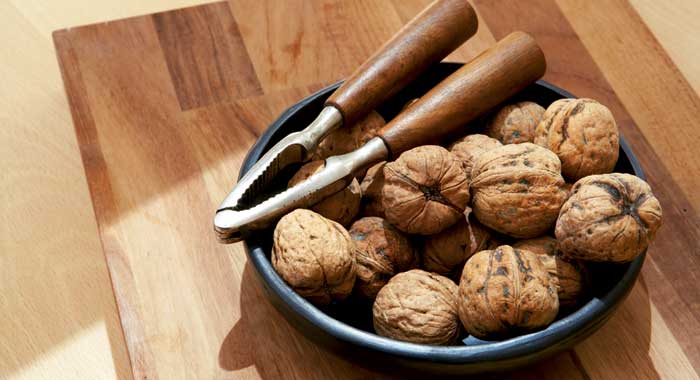
Pronounce it: wall-nut
Walnuts are one of the most popular and versatile of all nuts. When picked young, they’re known as wet and their milky white kernels are mainly used for pickling. Far more common is the dried nut, either shelled or unshelled. The brown-skinned kernel has a ridged surface, which looks like two halves of the brain.
Slightly bitter in flavour, walnuts are good eaten raw or cooked, in either sweet or savoury dishes, and are particularly useful for baking.
Find out about the health benefits of nuts.
Availability
Shelled walnuts are available all year round. Unshelled walnuts tend to be available in our winter months, from December to February.
Choose the best
If buying unshelled walnuts, look for those that are uncracked, with no holes. Shelled walnuts should be plump and crisp. Avoid any that look shivelled.
Prepare it
Walnuts in their shells can be opened using a nut cracker. To avoid damaging the nut inside, squeeze the shell gently until it cracks, then extract the nut – there are lots of different nut crackers available, so find one that’s easy for you to use.
Walnuts can be eaten raw, as they are, or toast to bring out more of their flavour: place the nuts on a baking sheet in a single layer and bake on a medium heat for 10-12 minutes. They are ready when the kernels turn golden. You can achieve the same effect by dry frying them: put in a dry frying pan over a medium heat, and keep the pan moving to make sure they colour evenly and don’t burn. Leave whole, halve or chop, as required.
Store it
Unshelled walnuts should be stored in an airtight container in a cool, dark place – they’ll last for around three months. Shelled walnuts should be kept in an airtight container in the fridge – they’ll last for up to six months.
Cook it
Add to salads (particularly Waldorf salad, with apple, celery and raisins) or muesli; use for baking cakes, biscuits or pies. Eat as a snack.
Alternatives
Try pecan.
Be the first to comment on "Walnut"